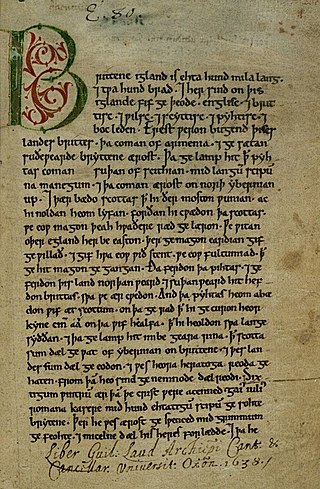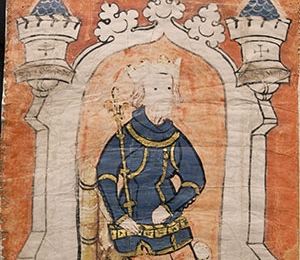A Royal Port is a port that has been granted a 'royal' designation by a monarch. In England, historically this designation allowed the port to receive certain goods and collect certain associated taxes.
Contents

A Royal Port is a port that has been granted a 'royal' designation by a monarch. In England, historically this designation allowed the port to receive certain goods and collect certain associated taxes.

During the medieval era's manorial system, Royal Ports were the direct property of the King, who would issue the port with special rights, customs and privileges, usually via a charter. Only those designated as royal ports could receive goods such as wine, and collect the associated royal tax on the imported goods on behalf of the king. These tolls or "customs" on imported or exported goods formed one of the oldest prerogatives enjoyed by Kings of England. [1] The king would appoint Royal Port Reeves to collect the tolls. [2] Ports that did not hold Royal status are historically called franchise ports.
The Kings of England designated Royal Ports in Ireland, such as Dublin, as part of their conquest. Perhaps one of the most famous examples would be linked to the Waterford Charter Roll, which resulted in the re-designation of Waterford as a Royal Port. Waterford had been designated as a royal port by Henry II, however nearby New Ross became a competing Port. In a bid to gain favour with Edward III over New Ross, the Roll was drawn up in a pictorial and colourful style showing that the city had had relationships with kings going back centuries. The king was persuaded by the Roll and reinstated Waterford's monopoly as a royal port. [3] [4]
Some were planned to deliberately compete with franchise ports not owned by the King. For example, Liverpool, was founded to compete with the port of Chester. King John wanted to turn Liverpool into a Royal Port as it offered a natural sheltered harbour, close to royal estates from which supplies could be withdrawn for military purposes as part of his conquest of Ireland. Chester may have been equally well suited for this, but it was a county palatine for the Earl's of Chester and therefore returned no profits to the crown. [5]
Often Royal Ports formed parts of confederations that granted them additional rights and privileges, such as Winchelsea which was part of the Cinque Ports or King's Lynn which formed part of the Hanseatic League. [6]
The framework for customs in the Royal Ports was set by the exchequer from as early as 1275. By 1347 the customs system, as it was to operate in the royal ports throughout the later Middle Ages was completed (excluding subsidies of tunnage on wine and poundage on general merchandise, which would be grafted on to the customs from about the middle of the fourteenth century). [7]

The Hanseatic League was a medieval commercial and defensive network of merchant guilds and market towns in Central and Northern Europe. Growing from a few North German towns in the late 12th century, the League expanded between the 13th and 15th centuries and ultimately encompassed nearly 200 settlements across eight modern-day countries, ranging from Estonia in the north and east, to the Netherlands in the west, and extended inland as far as Cologne, the Prussian regions and Kraków, Poland.
King's Lynn, known until 1537 as Bishop's Lynn and colloquially as Lynn, is a port and market town in the borough of King's Lynn and West Norfolk in the county of Norfolk, England. It is 36 miles (58 km) north-east of Peterborough, 44 miles (71 km) north-north-east of Cambridge and 44 miles (71 km) west of Norwich.

The Wash is a shallow natural rectangular bay and multiple estuary on the east coast of England in the United Kingdom. It is an inlet of the North Sea and is the largest multiple estuary system in the UK, as well as being the largest natural bay in England and is the outflow for the rivers Witham, Welland, Nene and the Great Ouse. It is also one of the most important places of conservation in Europe, with several nature reserves located within this area.

A market town is a settlement most common in Europe that obtained by custom or royal charter, in the Middle Ages, a market right, which allowed it to host a regular market; this distinguished it from a village or city. In Britain, small rural towns with a hinterland of villages are still commonly called market towns, as sometimes reflected in their names.

A marcher lord was a noble appointed by the king of England to guard the border between England and Wales.

The Freedom of the City is an honour bestowed by a municipality upon a valued member of the community, or upon a visiting celebrity or dignitary. Arising from the medieval practice of granting respected citizens freedom from serfdom, the tradition still lives on in countries such as the United States, United Kingdom, Ireland, Australia, Canada, South Africa and New Zealand—although today the title of "freeman" confers no special privileges. The Freedom of the City can also be granted by municipal authorities to military units which have earned the city's trust; in this context, it is sometimes called the Freedom of Entry. This allows them the freedom to parade through the city, and is an affirmation of the bond between the regiment and the citizenry.

Anglo-Saxon law was the legal system of Anglo-Saxon England from the 6th century until the Norman Conquest of 1066. It was a form of Germanic law based on unwritten custom known as folk-right and on written laws enacted by kings with the advice of their witan or council. By the later Anglo-Saxon period, a system of courts had developed to administer the law, while enforcement was the responsibility of ealdormen and royal officials such as sheriffs, in addition to self-policing by local communities.
The Steelyard, from the Middle Low German Stâlhof, was the kontor of the Hanseatic League in London, and their main trading base in England, between the 13th and 16th centuries. The main goods that the League exported from London were wool and from the 14th century woollen cloths. An important import good was beeswax. The kontor tended to be dominated by Rhenish and Westphalian traders, especially from Cologne.

The Anglo-Norman invasion of Ireland took place during the late 12th century, when Anglo-Normans gradually conquered and acquired large swathes of land in Ireland over which the monarchs of England then claimed sovereignty. The Anglo-Normans claimed the invasion was sanctioned by the papal bull Laudabiliter.

HM Customs was the national Customs service of England until a merger with the Department of Excise in 1909. The phrase 'HM Customs', in use since the Middle Ages, referred both to the customs dues themselves and to the office of state established for their collection, assessment and administration.

The Company of Merchant Adventurers of London was a trading company founded in the City of London in the early 15th century. It brought together leading merchants in a regulated company in the nature of a guild. Its members’ main business was exporting cloth, especially white (undyed) broadcloth, in exchange for a large range of foreign goods. It traded in northern European ports, competing with the Hanseatic League. It came to focus on Hamburg.
The history of Chester extends back nearly two millennia, covering all periods of British history in between then and the present day. The city of Chester was founded as a fort, known as Deva Vitrix, by the Romans in AD 70s, as early as AD 74 based on discovered lead pipes. The city was the scene of battles between warring Welsh and Saxon kingdoms throughout the post-Roman years until the Saxons strengthened the fort against raiding Danes.

Taxation in medieval England was the system of raising money for royal and governmental expenses. During the Anglo-Saxon period, the main forms of taxation were land taxes, although custom duties and fees to mint coins were also imposed. The most important tax of the late Anglo-Saxon period was the geld, a land tax first regularly collected in 1012 to pay for mercenaries. After the Norman Conquest of England in 1066, the geld continued to be collected until 1162, but it was eventually replaced with taxes on personal property and income.
Infangthief and outfangthief were privileges granted to feudal lords under Anglo-Saxon law by the kings of England. They permitted their bearers to execute summary justice on thieves within the borders of their own manors or fiefs.
Sir John Morice, Morris or Moriz was an English-born statesman of the fourteenth century whose career was mainly spent in Ireland. He is remembered chiefly for his enthusiastic, if not very successful, efforts to reform the Irish administration, and for the fact that a portrait of him still exists. This is said to be the earliest portrait of an Irish judge and can be viewed by the public.

The information about Scotland's domestic and foreign trade during the Middle Ages is limited. In the early Middle Ages the rise of Christianity meant that wine and precious metals were imported for use in religious rites. Imported goods found in archaeological sites of the period include ceramics and glass, while many sites indicate iron and precious metal working. The slave trade was also important and in the Irish Sea it may have been stimulated by the arrival of the Vikings from the late eighth century.

The Spanish Company was an English chartered company or corporate body established in 1530, and 1577, confirmed in 1604, and re-established in 1605 as President, Assistants and Fellowship of Merchants of England trading into Spain and Portugal, whose purpose was the facilitation and control of English trade between England and Spain through the establishment of a corporate monopoly of approved merchants.

Waterford Charter Roll is a historic legal document. It was created by the Anglo-Norman people of Waterford in the 14th century and its story shows us the power of English kings in Ireland through the medieval period to the 19th century. It is 4 m long and there are 17 individual drawings on the Roll.
Hugh Fenn, also written Fenne or atte Fenn, was an English businessman from Great Yarmouth in Norfolk who was active in local and national government during the reigns of Kings Richard II and Henry IV. It was a ship he part-owned which in 1406 captured the future King James I of Scotland.